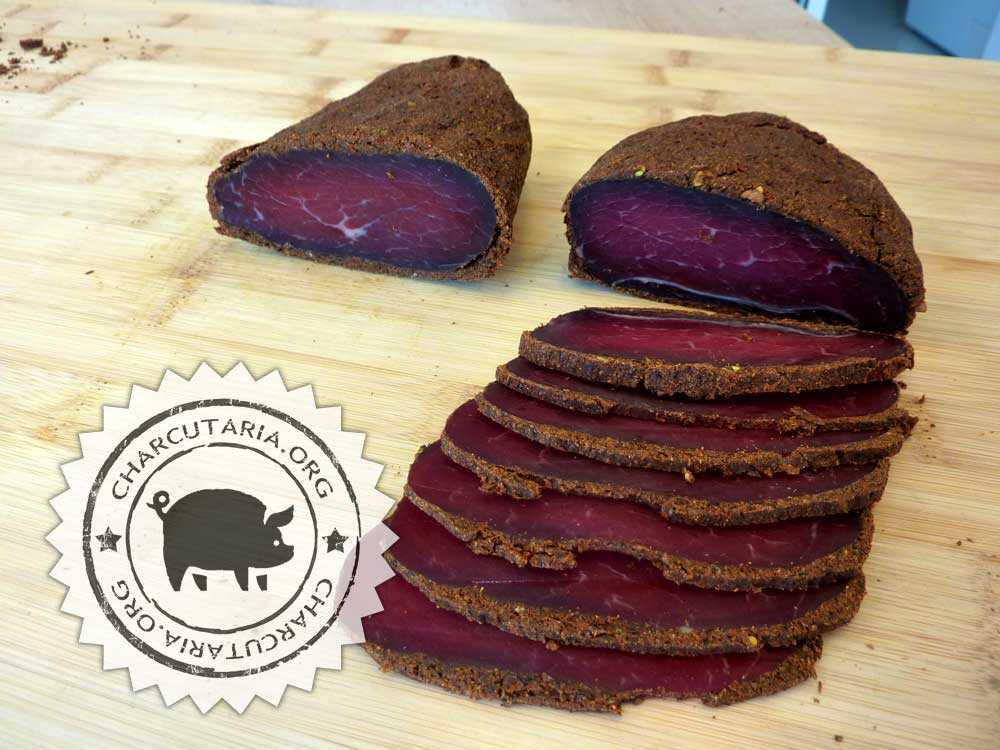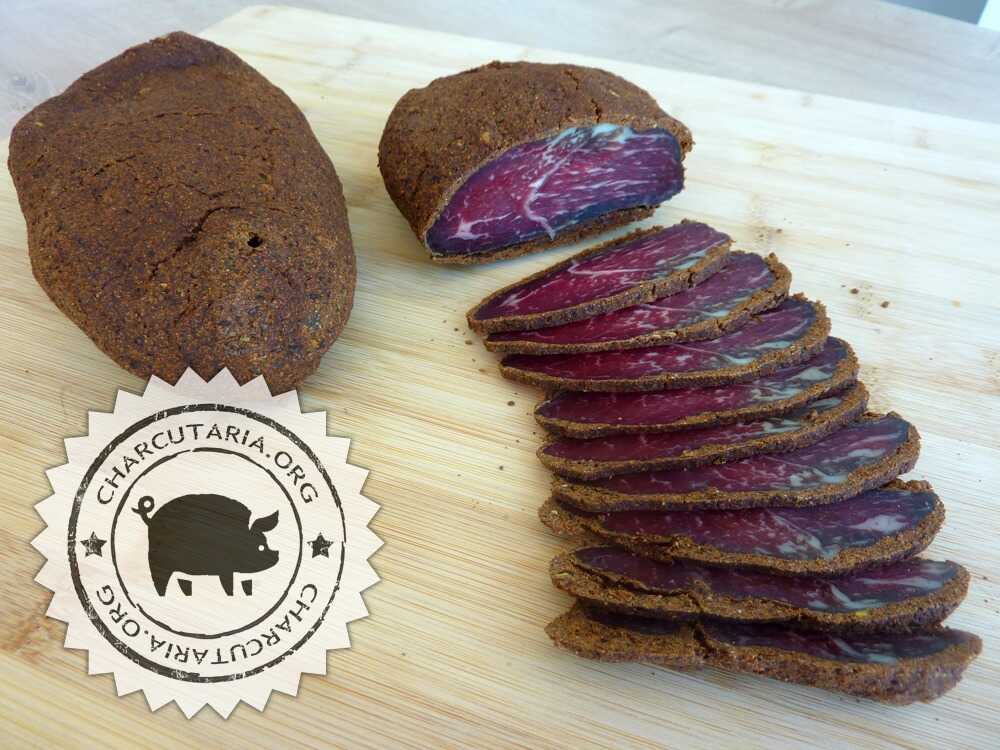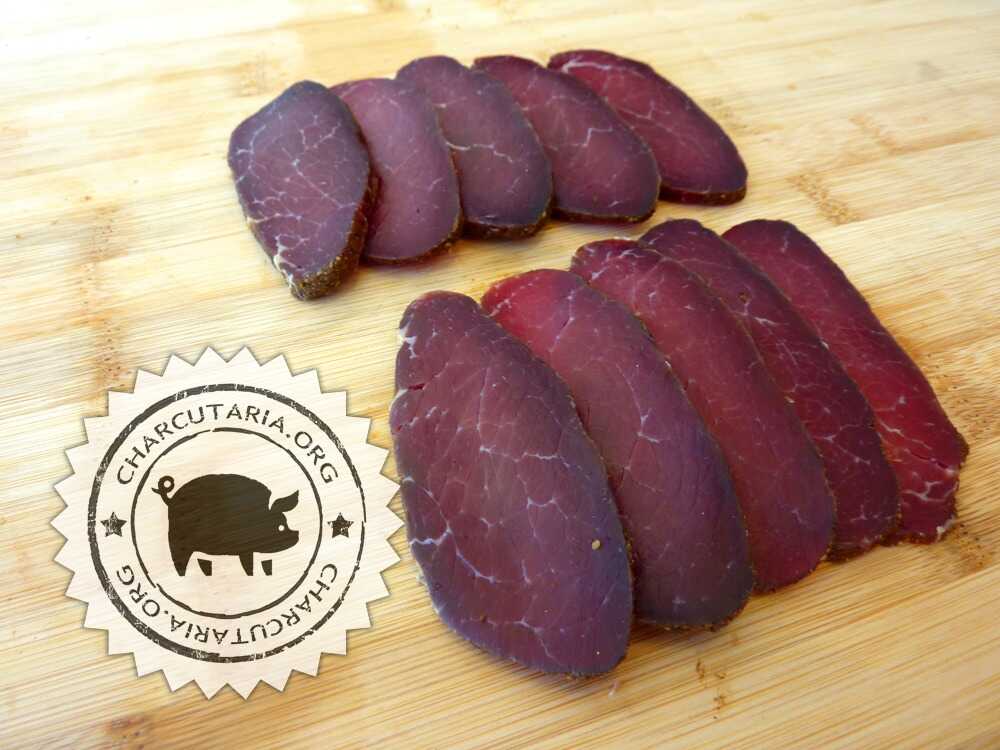
Pastirma or Basturma is cured beef with a heavily seasoned crust. It is a traditional product of Armenian and Turkish cuisine. The process first consists of salting, then it goes through an initial drying process, after this stage a seasoning is applied to the outside of the meat, forming a beautiful crust. It goes back to drying for another 20 days and is finally ready for consumption.
Pastırma is very traditional in cuisine east of the Mediterranean Sea and its places of consumption are related to the regions where there was a stronger presence of the Ottoman Empire. Pastırma is considered a food of Turkish cuisine and Armenian cuisine, however, it is produced and consumed not only in these countries, but also in many parts near or around Eastern Europe and the Middle East.
PASTIRMA / BASTURMA INGREDIENTS
- 1kg of lean beef;
- Coarse salt to cover the meat;
PASTA CONDIMENT FOR PASTIRMA / BASTURMA
- Salt – 14g
- Fenugreek – 43g
- Sweet paprika powder – 43g
- Black pepper powder – 14g
- Garlic powder – 14g
- Cayenne pepper powder – 7g
- Allspice powder – 14g
- Cumin powder – 14g
- 1 glass of warm water
PREPARING THE PASTE FOR PASTIRMA / BASTURMA
Mix all dry seasonings. Gradually add the warm water and mix until you get a thick paste that can be applied to the meat without falling or running. It should stick firmly to the meat.
PREPARATION OF PASTIRMA / BASTURMA
- Cover with coarse salt and keep refrigerated for 3 days.
- Remove any blood that comes out of the meat after the second day and turn the meat over;
- After 3 days, wash the meat well under running water and dry well with a cloth;
- Wrap in a cotton cloth or collagen sheet;
- Hang for 20 days in an environment with a temperature close to 10ºC, humidity of 70% and light and constant ventilation;
- After 20 days, wash the meat well under running water, dry well and apply a layer of seasoning paste sufficient to coat the entire meat;
- Hang for another 15 days in an environment with a temperature close to 10ºC, humidity of 70% and light and constant ventilation;
- After 15 days it will be ready for consumption;
- Remove the skin to consume.
Result and opinion
In terms of product, it was as expected, the meat was well cured, but not dry, the seasoning was spread evenly throughout the product, consistency and color were excellent.
Regarding the taste, Pastirma has a very striking flavor, mainly due to the fenugreek, which is an ingredient with a strong flavor and quite unknown to our palate. The salt is intense and the black pepper is also very present. It is not as well received as it is very different from the traditional taste of Brazil. It will please those who like products with a more intense flavor and displease those who prefer softer and more traditional products. It's worth it for anyone who wants to discover a new product that is very different from what we know.

basturma pastirma 
basturma pastirma 
basturma pastirma




The secret is to cut it very thinly (almost transparent to the light). I always buy it at Naha with his son, Paulo Haladjian. They are the best in SP, but I'm going to try to make them. I eat it with fenugreek paste accompanied by a red wine. It's striking, I love it, but not everyone likes Basdrma!
If anyone wants it, I can send Naha's phone number.
Hi, is coarse salt enough or do you need curing salt? Thank you and congratulations on the website
Just common salt is enough, curing salt is an additional addition that will help provide more protection and durability.
I made Pastirma or BASTURMA with pork loin, but I haven't tried it yet. I think it turned out good.
N
Hello, I thought the recipe was super cool! I started it, but I also had problems after the first 20 days. When I took the meat out of the cloth it had small spots on it, which I believe to be bacteria. Out of doubt, I discarded the piece and will try again. From the photo, do you think this is the case?
Congratulations on the work!
Hug
Hi Pedro, apparently there was fungal contamination, but it's difficult to be sure from the photo. What you could do is take a thin slice of these contaminated regions and continue with the process. Basturma has a more complicated process, so it's a bigger challenge. Clean the cloth with bleach before using, this usually eliminates the spores that are trapped in the weave of the fabric. Another option is to use collagen film in this step.
Hi…I'm interested in buying basturmã. Do you deliver to other states (SC). But I couldn't find it on the local website to order this product!!
Hi Sergio. We do not sell finished products, only the inputs to produce them.
Where can I get this fenugreek and can I replace it with another spice?
Hi Julio, you can find fenugreek in health food stores. You can replace it with another condiment or even corn flour just to add volume and cover the piece because in addition to the flavor, the coating serves to create a barrier that protects and controls moisture loss.
How could I use beef lizard in the meat curing/maturing process, is there a recipe for this product
Hello! I was making Pastirma here according to the video and the recommended recipe… I made it from ducklings, cut into 4 smaller pieces without fat. Salting was OK, washing was also OK... but after the cold drying stage in the fridge, wrapped in cotton cloth (I used that gauze-like fabric used to make cheese, cheesecloth style), also done in a closed plastic container with a cooler inside and temperature controller in the refrigerator (it should be stabilizing at around 7-10 C according to measurements), after 20 days at this stage, I went to unwrap the meat from the cloths so I could make the spice shell and realized that there was a white mold covering it. almost the entire surface of the meat (even spilling over the cloth)… it looks very much like some type of Penicillium. the meat doesn't have a bad smell, it doesn't have the aroma of spoiled meat (it has a similar aroma to Brie cheese, hence the suspicion that the mold is Penicillium), and when you cut a piece you can see that it is OK inside (it's just not as dry as I expected or as in the video). I think it may not have dried that much, or it may have absorbed too much water during immersion, and little by little… Read more "
Hi Pedro, from the photos and the report it seems to be positive mold. The mold coating creates a barrier that slows moisture loss, so it's normal for it to be a little softer than it would otherwise be. For all this, I think you can clean the pieces well under running water and proceed to coating them with the spices. If it were mine I wouldn't throw it away and keep going. The smell of brie is also another indication that mold is beneficial.
Thank you Eduardo! That's exactly what I thought! I didn't throw it away, I stored it in the fridge until I decided how to proceed. I believe I will wash as indicated on another website I found (an American one, I believe): clean, wash in brine by immersion, dry and continue maturation.
Hi, I've been following the site for some time now, excellent recipes and very well explained. I decided to put this recipe into practice, which is almost ready to be seasoned, and then two questions arose: can I use crushed fresh garlic instead of powdered garlic? and can I add dryrub or is there a risk of it spoiling due to the sugar?
Hi Mateus, yes, you can substitute garlic, no problem. Regarding dry rub, if it contains sugar in the composition, then it is best to avoid it. Sugar is a food source for many bacteria and some type of unknown fermentation may occur. Better to avoid. If you use a starter culture, then sugar is beneficial, limited to 5% on the weight of the meat.
Could you make a video like this teaching how to make BILTONG, I went to South Africa a few years ago and ate it and loved it, I tried to make it a few times here in Brazil but it didn't work out very well, the recipes I tried to make are very similar to the basturma one , I'm going to try to do it again, adapting it with your recipe, anyway, it would be really cool and very useful if you made one about Biltong!!! By the way, congratulations on the YouTube channel, very good!!!
Sensational.